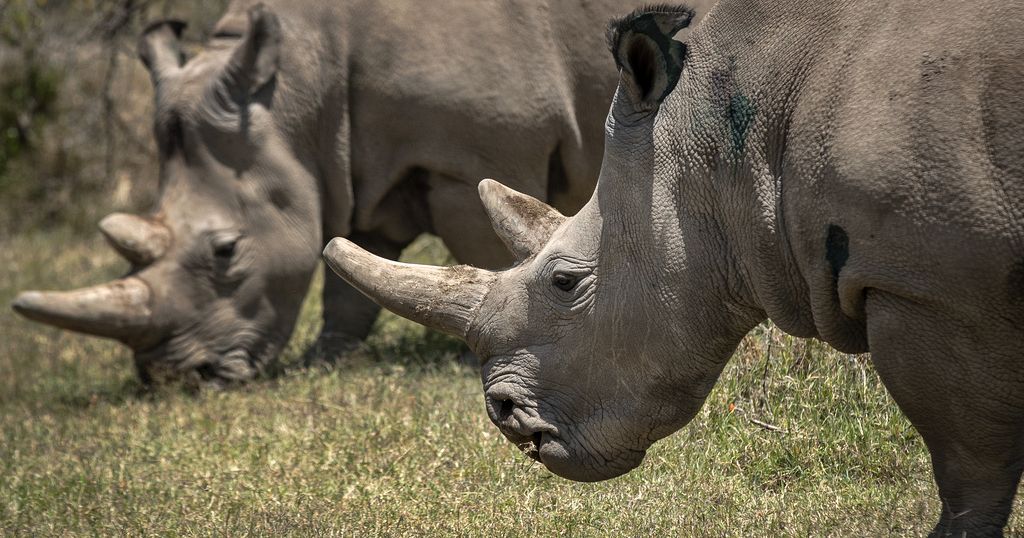
Here protected at Kenya’s Ol Pejeta Conservancy are Najin and Fatu.
They are the last two northern white rhino left on Earth.
They’re both female but not young or healthy enough to carry a full pregnancy.
There is no northern white male, the last one died in 2018.
Now the international group of scientists called BioRescue say they’ve shown IVF techniques could save them from extinction.
They have reported that a southern white rhino became pregnant with a southern white rhino embryo.
However the mother rhino and her embryo died after 70 days due to a bacterial infection.
Despite this the team say the pregnancy, which is the world’s first rhino IVF pregnancy, is great news for the species.
Professor Thomas Hildebrandt is BioRescue lead researchers and the head of the Department of Reproduction.
He says: “Now we have the clear evidence that an embryo that is frozen, thawed, produced in a test tube can produce new life and that is what we want for the northern white rhino.”
The scientists carried out the procedure implanting a southern white embryo into a southern white surrogate mother on 24 September in 2023.
Members of the conservation team called BioRescue say the IVF resulted in the 70 day pregnancy of a well developed male embryo which was 6.4 centimetres long.
However, the team were not aware of the pregnancy until the end of November in 2023.
It only came to light because of the examination of the female rhino after she died from a bacterial infection caused after spores from the clostridium strain were released from the soil from floodwater.
The safety of the remaining surrogates and the last two remaining northern white rhinos Najin and Fatu was secured by quarantines and a vaccination programme.
The scientists say the death of the surrogate and her embryo was not related to the pregnancy.
They believe the success of the embryo’s implantation and length of the pregnancy shows they’re mission to save the northern white rhino from extinction is on course.
The next step for the scientists is to choose and prepare what they describe as a ‘teaser bull’ which will reveal when the potential surrogate mothers can be implanted with embryos.
The scientists need to ensure they select the animal which has been demonstrated to be reproductively sound.
Hildebrandt explains: “We assess productive health of each individual so that we can have a better idea how the outcome of our intervention will be. So it is a very complex program and we are very, very happy that we have now achieved this milestone. Before it was oocyte collection in the rhinoceros because it’s a very challenging procedure to harvest oocytes from a two ton individual. Then the next step which we achieved was producing out of these oocytes in a test tube, the first embryos. And now we can show even the embryos are frozen and kept in liquid nitrogen for several years we thaw them and they are capable to produce new life.”
This process can take several months, but only after the successful conclusion of this stage of the programme will the scientists attempt an embryo transfer with a northern white rhino.
It’s at this stage that the BioRescue consortium hope they will have paved the way for the first northern white rhino calf to be born by artificial reproduction.
Although carried to term by the southern whites the calves born will be purely northern white rhinos.
However the behaviours of the two species is different because they are from different parts of the African continent.
Hildebrandt says the remaining northern white rhinos will be crucial in socialising the young.
“The baby will be raised milk wise by lactation from the southern white rhino, but it will spend most of the time in our plan with the northern white rhino to learn how to be a northern white rhino , because that is a really important element of surviving in the landscape of central Africa, because a southern white rhino lives on the savannah, which is a completely different habitat than what the northern white rhinos actually do.”
It’s been a long and difficult mission, and there is a long way to go but the scientists are taking their success as succour for the long journey ahead.
And the science doesn’t end with the IVF as Hildebrandt points out.
“The last northern white rhino you have to remember, was born in 2000. That was the last little baby which hit the ground from this subspecies. So we have had the gap of more than 20 years but with this new technology, we see that we have a really fair chance to achieve this the first pregnancy of this magnificent species in this year. But the pregnancy length of a rhino or takes 16 months so it’s a long journey for the baby. However, that brings us to the births in early 2026. And then from there we will have many more rhinos because we have already 30 embryos, pure northern white rhino embryos which are all waiting for being transferred. And then when the first babies are born, we have working on the genetic variation the stem cell technology, where we use skin cells from deceased animals to provide more genes for the population,” says Hildebrandt.
Hildebrandt says the reproductive science they’ve learned can be used to help other species, but he cautions this should not be considered a solution for destroying current animal habitats.
“It can be used as a blueprint for other critically endangered, like the north Sumatran rhino, however we should keep really in mind that it is a very expensive and very complicated process and it should be not a blank card for bad decision makers so that they are irresponsible with the natural resources of our planet, we want to fix mistakes, errors from the past, but we will not provide a new toolbox for making future bad decisions,” he says.
Read More: World News | Entertainment News | Celeb News
African News





